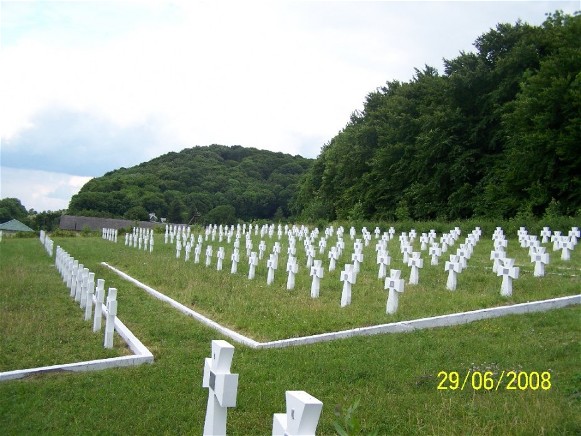Division Galizien
Division Galizien (14 Waffen-Grenadier-Division der SS, Galizische Nr 1), later the 1st Ukrainian Division of the Ukrainian National Army (1 Division der Ukrainischen National-Armee). Ukrainian military formation in the German armed forces during the Second World War. The division was organized as part of a program of creating foreign (eg, Estonian, Latvian) formations of the Waffen SS to fight on the Soviet front. The organizer of the division was the German governor of Galicia, Otto von Wächter, and its formation was announced on 28 April 1943. The head of the Ukrainian Central Committee in Cracow, Volodymyr Kubijovyč, supported the division’s formation, regarding it as a Ukrainian armed force and hoping to influence its character and organization as the core of a future national army. During the preliminary negotiations the Germans gave assurances that the division would fight only against the Red Army, allowed Ukrainian chaplains to serve with the division, undertook to train Ukrainian officer cadres, and released a number of Ukrainian political prisoners. A military administration was created to conduct recruitment, assist the families of volunteers, and organize cultural and educational activities for the soldiers. There were more than 80,000 candidates for the division, of which 42,000 enlisted and 27,000 were called up; only about half were accepted.
The division consisted of three infantry regiments, one artillery regiment, and a regiment of training reserves; three battalions of fusiliers, sappers, and field reserves; communications and antiaircraft artillery detachments; and auxiliary units, including a field hospital. There were 15,000–18,000 soldiers in all. The division command (all senior-rank officers) and technical corps consisted entirely of Germans, which created friction, especially because the German authorities considered the Ukrainians merely ‘Galicians.’
In the summer of 1944 the division saw action at the front; while attached to the 13th Army Corps, it was surrounded and destroyed at the Battle of Brody during the Soviet offensive. It was regrouped, replenished with reserves and new recruits, and transferred to a location near the town of Žilina in Slovakia (October 1944–January 1945); later, following a march to Slovenia, it was deployed near the town of Maribor. Although an order was received there from Adolf Hitler to disarm the division, it was sent to fill gaps on the Austrian front (Feldbach–Bad Gleichenberg). In March 1945 the German government announced the formation of the Ukrainian National Army under the command of General Pavlo Shandruk, who joined the division in April. Under his auspices the division was formally attached to the Ukrainian National Army as its First Division. On 25 April 1945 the division’s troops swore a new oath of loyalty to the Ukrainian people. During Germany’s capitulation most of the troops (some 10,000) surrendered to the British; the commanding officer, Gen F. Freitag, shot himself. Command of the division in captivity was taken over by General Mykhailo Krat. After the prisoners of war had been transferred from Italy (where they had spent almost two years in prisoner of war camps) to Britain, they worked as contract laborers and were later released. Most of them then emigrated to North America. The Brotherhood of Former Soldiers of the First Ukrainian Division of the Ukrainian National Army was established in 1950.
BIBLIOGRAPHY
Lysiak, O., ed. Brody: Zbirnyk stattei i narysiv (Munich 1951)
Shandruk, P. Arms of Valor (New York 1959). Online at www.irekw.internetdsl.pl/shandruk/
Tys-Krojmaluk, J. [Tys-Krokhmaliuk, Iu.] Guerra y libertad: Historia de la Division ‘Halychyna’ (D. U. 1) del Ejercito Nacional Ucraino (1943–1945) (Buenos Aires 1961)
Pan'kivs'kyi, K. Roky nimets'koï okupatsiï, 1941–1944 (New York 1965; 2nd edn 1983)
Höhne, H. The Order of the Death’s Head: The Story of Hitler’s SS, trans R. Barry (London 1969)
Haike, V.-D. [Heike, W.-D.] Ukraïns'ka dyviziia ‘Halychyna’: Istoriia formuvannia i boiovykh dii u 1943–45 rokakh (Toronto–Paris–Munich 1970)
Krokhmaliuk, R. Zahrava na Skhodi: Spohady i dokumenty z pratsi u Viis'kovii upravi ‘Halychyna’ v 1943–1945 rokakh (Toronto–New York 1978)
Veryha, V. Dorohamy Druhoï Svitovoï viiny: Legendy pro uchast' ukraïntsiv u Varshavs'komu povstanni 1944 ta pro Ukraïns'ku Dyviziiu ‘Halychyna’, 2nd edn (Toronto 1981)
Heike, W.-D. The Ukrainian Division ‘Galicia,’ 1943–1945: A Memoir (New York 1988)
Poryv: Pravda pro Pershu Ukraïns'ku Dyviziiu ‘Halychyna’ (UNA) (Statti, narysy, spohady) (Lviv 1994)
Logusz, M. Galicia Division: The Waffen-SS 14th Grenadier Division 1943–1945 (Atglen, Pennsylvania 1997)
Caballero J. C. Breaking the Chains: 14 Waffen-Grenadier-Division der SS and Other Ukrainian Volunteer Formations, Eastern Front, 1941–45, trans R. Haigh (Halifax, U.K. 1998)
Bolianovs'kyi, A. Dyviziia ‘Halychyna’ (Lviv 2000)
Hunczak, T. On the Horns of a Dilemma: The Story of the Ukrainian Division Halychyna (New York 2000)
Melnyk, Michael James. To Battle!: The Formation and History of the 14th Galician Waffen SS Division (Solihull, UK 2002; revised edn 2006)
Shkandrij, Myroslav. In the Maelstrom: The Waffen-SS ‘Galicia’ Division and Its Legacy (Montreal 2023)
Roman Krokhmaliuk
[This article originally appeared in the Encyclopedia of Ukraine, vol. 1 (1984).]
